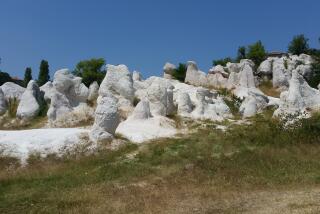Op-Ed: Most of us are clueless about humanity’s place in the planet’s long history. We need to learn ‘timefulness’
- Share via
For a few weeks each February, small towns pop up like Brigadoons on the ice covering Lake Winnebago, the largest inland water body in Wisconsin. Winnebago is a vestige of the much larger Glacial Lake Oshkosh, which formed from ponded meltwater late in the Ice Age and left behind heavy clay sediment that is the bane of gardeners. Lake Winnebago is often alarmingly green in the summer as a result of runoff from lawns and farms, but it still supports a healthy population of lake sturgeon. Each year, before they head into upstream tributaries to spawn, the sturgeon congregate in a few bays, and the temporary towns start to appear on the ice, mirroring the fish communities below.
Sturgeon are large fish; the record setter for the area was 240 pounds (bigger, as the local paper pointed out, than a popular Packers linebacker). They have lifespans longer than humans, and their lineage has been around since the early Cretaceous, about 140 million years ago. They are caught not with delicate hooks and lines dropped through narrow auger holes but with trident-like spears plunged into large rectangular openings sawed in the ice.
In the winter of 1953, when almost 3,000 fish were taken, the public awoke to the reality that the sturgeon could soon be harvested to extinction. Sturgeon fishers and the Wisconsin Department of Natural Resources began to work together to monitor the population and set catch limits. As soon as the quota for a given year is reached, the season ends, sometimes just hours after it opened. At weigh stations on shore, each fish is sexed and weighed, and its age is estimated from a slice of its dorsal fin, which has growth bands like tree rings. Just think — that one hatched the year the Titanic sank! The weigh station is itself an ephemeral village, where people of all ages gather to see the giant fish pulled from this parallel, primeval world.
A defining characteristic of modern society, French philosopher Bruno Latour argues, is “a peculiar propensity for understanding time that passes as if it were really abolishing the past behind it.” We think that our technologies exempt us from the constraints of natural history that for so long defined the human experience. But stranded on the island of Now, we are lonely.
When I see people crowded together in the cold to watch big, old, ugly fish being weighed, I sense a very un-modern yearning to connect with the past. And I suspect that our self-imposed exile from it is the source of many ills: Environmental malefactions and existential malaise are both rooted in a distorted sense of humanity’s place in the history of the natural world. People would treat one another, and the planet, better if we recognized our shared past and common destiny as lucky inheritors and eventual bequeathers of the Earth estate. In short, we need a new relationship with time, a habit of mind that could be called timefulness.
As a geologist and professor, I speak and write rather cavalierly about eras and eons. One of the courses I routinely teach is “History of Earth and Life,” a survey of the 4 ½-billion-year saga of the entire planet – in a 10-week academic term. But as a daughter, mother and widow, I struggle like everyone else to look time honestly in the face.
Antipathy toward time rooted in the very human combination of vanity and existential dread is perhaps the most forgivable type of chronophobia. But more dangerous forms of time denial pervade our society. Fiscal years and congressional terms enforce a blinkered view of the future. Short-term thinkers are rewarded with bonuses and reelection, while those who dare to take seriously our responsibility to future generations find themselves out of office. Even two years of forethought seem beyond the capacity of legislators these days, when stop-gap spending measures have become the norm. Institutions that do aspire to the long view — state and national parks, public libraries and universities — are increasingly seen as taxpayer burdens.
We would be shocked if an educated adult were unable to identify the continents on a world map, yet are untroubled at widespread obliviousness about anything but the most superficial highlights from the planet’s long history (um, Bering Strait … dinosaurs … Pangaea?). We lack a sense of temporal proportion — the durations of the great chapters in Earth’s history, the rates of change during previous intervals of climate instability, the intrinsic time-scales of “natural capital” like groundwater systems.
Enter the Fray: First takes on the news of the minute from L.A. Times Opinion »
We are, in effect, time illiterate, and this ignorance of planetary time undermines any claims we may make to modernity. We are navigating recklessly toward our future using conceptions of time as primitive as the pre-Copernican view of the universe. We think we’re the center of it all, unable to see either the past or future in proper perspective.
Fathoming deep time is geology’s great, undervalued, contribution to humanity. Just as the microscope and telescope extended our vision into spatial realms once too tiny or too distant for us to see, geology provides a lens through which we can witness time in a way that transcends the limits of human experience. But geology is less about time itself than its capacity to transfigure, destroy, renew, erode, entwine, innovate, exterminate.
Although we may fervently wish to resist time, we diminish ourselves, and imperil those who will come after us, by denying our temporality. For many in North America, the 2017 solar eclipse was a transformative experience, a fleeting vision of our place in the cosmos. Similarly, geologic thinking provides a view of the strange and scintillating world of time we dwell in but cannot ordinarily see, swimming just beneath our feet, like the sturgeon under the ice. Even a glimpse can alter one’s experience of being alive on Earth.
Marcia Bjornerud is a professor of geosciences at Lawrence University in Appleton, Wis., and author of “Timefulness: How Thinking Like a Geologist Can Help Save the World,” from which this essay is adapted.
Follow the Opinion section on Twitter @latimesopinion and Facebook
More to Read
A cure for the common opinion
Get thought-provoking perspectives with our weekly newsletter.
You may occasionally receive promotional content from the Los Angeles Times.









